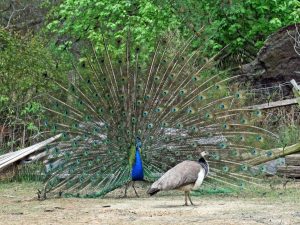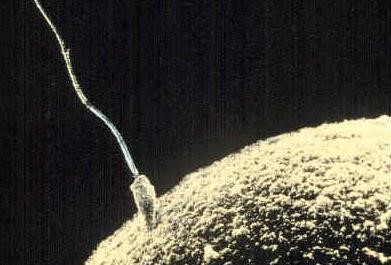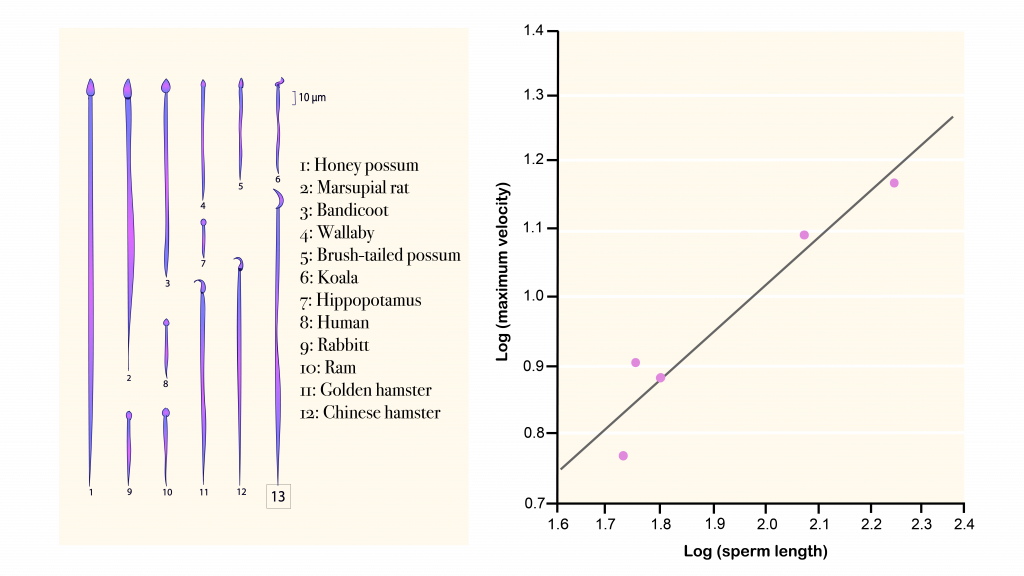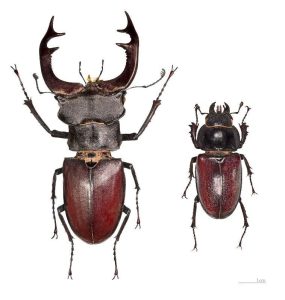4 Chapter 4: Sexual Selection
Mason Tedeschi; Lisa Limeri; and Anastasia Chouvalova
Learning Objectives
By the end of this section, students will be able to:
- Compare and contrast artificial, natural, and sexual selection.
- Describe the hypothesized mechanisms of intersexual selection (sexy sons, good genes, handicap, and direct benefits hypotheses).
- Contrast intrasexual selection and intersexual selection.
- Describe the relationship between sexual selection and sexual dimorphism
Sexual Selection
When discussing natural selection and adaptations, we often focus on traits that help an organism survive – surviving cold winters, avoiding predators, obtaining food, etc. But what about traits that do not directly aid in survival? Or better yet, what about traits that actually hinder survival? Consider the elaborate train feathers of a peacock (Fig 4.1). These feathers, while visually stunning, make it nearly impossible for an individual to fly. Not only that, but these feathers also make it easier for a predator to spot a peacock from a distance and they can also be used by a predator to apprehend a peacock so it cannot escape. Rather than helping a peacock survive, their tail feathers actually make it more difficult to escape predation. So does such a trait evolve?
This question can be answered by viewing this trait not as aiding in survival, but as a trait that aids in reproduction. Exaggerated traits, like the tail feathers of a peacock, are used to attract females for mating, ensuring that a male passes his genes on to the next generation.
Elaborate peacock trains (Fig 4.1) represent an example of sexual selection. Sexual selection is a “special case” of natural selection in which individuals compete for mates in order to pass on their genes to future generations. The peacock’s train is used to attract females for mating, ensuring that a male passes his genes on to the next generation. In essence, sexual selection acts on an individual’s ability to successfully reproduce- even if that ability comes at a cost to survival.

Darwin identified a special case of natural selection that he called sexual selection. Sexual selection acts on traits that affect an individual’s ability to attract mates and thus produce offspring. Sexual selection often leads to the evolution of dramatic traits that often appear maladaptive in terms of survival but persist because they give their owners greater reproductive success. Sexual selection can be so strong that it selects traits that are actually detrimental to the individual’s survival.
Sexual selection occurs through two mechanisms: intrasexual selection of mates, also known as mate competition and [latex]null[/latex] and intersexual selection, also known as mate selection/choice.
Mechanisms of Sexual Selection
Sexual selection, the process through which individuals compete for mates, primarily takes two forms: intersexual selection and intrasexual selection. Intersexual selection, often referred to as mate choice, involves individuals of one sex choosing among members of the opposite sex based on the attractiveness of certain traits that those individuals possess. Intrasexual selection, also called mate competition, involves one sex competing with members of the same sex for access to mates.
Sexual selection results from competition over mates. Which sex competes for mates and which sex is choosy? In general, the sex that invests more resources in offspring is the one that will be more choosy, because they have more to lose by making a bad choice about a mate. This investment difference begins with gametes. Females produce eggs, which are much larger in size (and thus more costly to produce) and males produce sperm, which are small and energetically cheap (Fig 4.2). This difference in gamete investment is known as anisogamy.

This early investment difference resulting from anisogamy causes the general trend that in most species, females are the choosy sex and males are the sex competing for female to mate with. Another reason why females are typically the choosy sex has to do with the level of investment in offspring care, known as parental care. For example, following sexual reproduction and fertilization, most mammals develop within the body of their mothers. The developing offspring of most mammals then get their food and oxygen from the blood of their mothers through a spongy organ called the placenta. Even marsupial offspring, though not fully developed when born, are usually carried by their mothers in a pouch until they are able to walk on their own.
However, it is important to note that not all species follow this trend. In some animals, males provide a great deal of parental care to their offspring. For example, in emperor penguins each female produces a single egg. She then transfers the egg to her male mate and leaves to spend the winter in the open ocean in search of food and other resources. During the Antarctic winter, which lasts about four months, male emperor penguins huddle in groups, guarding their eggs and keeping them warm. Another example is seahorses, where males incubate eggs and care for young in a pouch. When they mate, a female deposits eggs into the male’s pouch and leaves, providing no further parental care. Thus, male seahorses invest far more resources into offspring than females do, and it’s the males who are the choosy sex and females compete for male mates.
Question #1
Classify each of the following scenarios as examples of intrasexual selection or intersexual selection.
A. Male emporer penguins choose to incubate eggs from larger females.
B. Male leaf-footed cactus bugs fight for mates using spines on their hind legs.
C. Dominant male red deer monopolize a group of females (also known as harem) by constantly fighting off other male competitors.
D. Female red-necked phalaropes (a species of duck) are larger and more aggressive than males and the females fight with each other for the opportunity to mate with males, who provide all the parental care to offspring.
Intrasexual Selection: Competition
Intrasexual (within sex) competition takes the form of conflicts between members of the same sex competing for mates. These intrasexual competitions are often ritualized, but may also pose significant threats to the competitors’ survival. Intrasexual selection involves mating displays and aggressive mating rituals such as rams butting heads—the winner of these battles is the one that is able to mate. Many of these rituals use up considerable energy but result in the selection of the healthiest, strongest, and/or most dominant individuals for mating. Sometimes the competition is for territory, with prospective mates more likely to mate with individuals with higher quality territories.
Intersexual Selection: Mate Choice
Intersexual (between sexes) selection occurs when members of the choosy sex select a mate based on a trait or suite of traits, such as feather colors, the performance of a mating dance, or the building of an elaborate structure. There are several, non-exclusive models of how and why mating preferences evolve. Broadly, there are two types of fitness benefits that drive mate choice: direct benefits and indirect benefits.
Direct Benefits
Direct benefits increase the fitness of choosy individuals through material resources. Members of the competing sex will sometimes provide members of the choosy sex with a food gift before mating. These resources, called nuptial gifts, provide nourishment to prospective mates that they may not otherwise get. For example, male great grey shrikes- a predatory bird- will present prey items (e.g., rodents, other birds, lizards) to females immediately before mating. A female great grey shrike will choose a mate according to the size of the prey item presented to her. Nuptial gifts are observed in many insects and spiders where males present nuptial food gifts to females in the hopes that she will choose to mate with him.
In extreme cases, the competing sex will even sacrifice parts or all of themselves to members of the choosy sex. For example, in some species of ground crickets, females receive a nuptial gift by chewing on a specialized spur structure on the male hind tibia (i.e. leg) while mating. Most predatory species of preying mantids practice a type of extreme nuptial feeding known as sexual cannibalism, in which a female will eat her mate prior to, during, or after copulation. Most often, a female mantid will begin feeding by biting off the head of a male, as they would with regular prey. Because copulatory movement in males is controlled by nerves in the abdomen, not the head, removal of a male’s head does not affect mating, sperm transfer, or proper fertilization. The reason for sexual cannibalism has been heavily debated. Experiments show that females on low quality diets are more likely to cannibalize her mates, compared with females given high quality diets. Thus, nuptial gifts are typically considered a direct benefit, because they enhance a female’s survival and reproduction. Some suggest that males that submit to females and are cannibalized gain a selective advantage by producing higher quality offspring. In any event, this type of sexual behavior is quite rare because the costs are often assumed to out-weigh the benefits, particularly for males.
Question #2
What are nuptial gifts?
A. A form of indirect benefits to the choosy sex.
B. Resources typically provided by the competitive sex to the choosy sex.
C. Resources typically provided by the choosy sex to the competitive sex.
D. A form of intrasexual competition.
Indirect Benefits
Indirect benefits do not directly benefit the choosing individual, but rather, indirectly benefit them by increasing the fitness of their offspring. There are multiple hypothesized mechanisms of indirect benefits. Three of the most common and well-supported are the Sexy Sons, Good Genes and Handicap Hypotheses.
The Sexy Sons Hypothesis: The sexy sons hypothesis postulates that members of the choosy sex who select mates with attractive traits will benefit by producing offspring who also possess the attractive traits and thus will be reproductively successful. As such, the attractive (sexy) sons will be more likely to attract females, and thus the choosy female’s genes will continue to spread.
The Good Genes Hypothesis. The good genes hypothesis posits that males develop impressive ornaments to show off their efficient metabolism or effectiveness at obtaining food, or their ability to fight disease. Females then choose males with the most impressive traits because it signals their genetic superiority, which they will then pass on to their offspring.
The Handicap Hypothesis. Exaggerated traits, such as the Peacock’s train, that exist to attract mates can reduce the owner’s survival. Why would females prefer to mate with males that have traits that reduce survival? The Handicap hypothesis poses that a male with a large, elaborate train must be especially strong and fast to escape predators while having a handicap, and thus makes an ideal mate.
In both the handicap principle and the good genes hypothesis, the trait is an honest signal of the males’ quality, thus giving females a way to find the fittest mates— males that will pass the best genes to their offspring.
Question #3
In a species of bird, males with a large, elaborate traits are preferred by females as mates because they must be especially strong and fast to escape predators despite having such an unwieldy trait. This describes which hypothesized mechanism of sexual selection?
A. Sexy Sons hypothesis
B. Good genes hypothesis
C. Handicap hypothesis
D. Direct benefits hypothesis
Post-Copulatory Sexual Selection
Sexual selection does not come to a halt after animals have mated. If a female mates with multiple males, such that sperm from several individuals remains in her body for an extended period of time, sexual selection can continue long after a male and female have mated. Just like with sexual selection before mating, post-copulatory sexual selection occurs in two forms: cryptic female choice– an extension of mate choice; and sperm competition– an extension of mate competition.
Cryptic female choice
Using physical or chemical mechanisms, females can bias paternity and affect male reproductive success by choosing whether certain sperm are successful in fertilizing their eggs. The term “cryptic” is used to describe an internal, and thereby hidden, process that females employ to choose the sperm from males that they prefer. The research suggests that cryptic female choice is likely a consequence of sexual conflict regarding the frequency and mode of mating. While males increase their fitness by successfully mating with as many females as possible, and thereby fertilizing as many eggs as possible from different females, females can incur fitness costs associated with mating with many males. Cryptic female choice reduces these costs by allowing females to mate multiply (as males wish to do), but then only select sperm from the favorable males afterwards. Here, females benefit by influencing paternity in favor of the males they prefer- possibly because they provide some direct or indirect benefit to her.
Sperm competition
Sperm competition, an extension of intrasexual competition, is the process by which sperm from two or more males compete for fertilization of a female’s eggs. Sperm competition is often compared to having tickets in a raffle: a male has a better chance of having their ticket drawn (i.e. fathering offspring) if he has more tickets in the raffle (i.e. he releases more sperm per ejaculate into a female’s reproductive tract). Alternatively, males may not release more sperm, but instead they evolve faster, more motile sperm that allow an individual’s sperm to reach a female’s eggs first. Among the best evidence we have for sperm competition is the evolution of longer sperm tails in animals that have multiple partners (Fig 4.3).

Sexual Dimorphism
Just as with natural selection, sexual selection can lead to changes in the genetic composition of a population that can be seen through physical changes to the way an organism looks. Both mate choice and mate competition can lead to the evolution of elaborate traits, termed secondary sexual traits, (secondary because they are not the primary traits involved in sexual reproduction or sperm transfer). Secondary sexual traits aid in sexual reproduction by improving an individual’s ability to obtain mates. Typically, one sex possesses an elaborate secondary sexual trait or traits, but the other sex does not, a condition called sexual dimorphism (Fig 4.4). Both mate choice and mate competition can involve the evolution of secondary traits that are sexually dimorphic.

Traits that are subject to selection via mate choice are referred to as ornaments or sexual signals. Ornaments can involve different signal modalities, including visual signals like the bright colors of many birds and butterflies; olfactory (i.e. chemical) signals like the scent patches that many mammal species use to attract mates; auditory signals used by chorusing frogs and some insects like crickets; or even tactile signals like the vibratory signals used by some spiders when they tap their legs on the surface of a leaf to attract mates. Sexual signals can also involve multiple signal modalities. For example, male jumping spiders will often use both visual and vibratory signals when trying to attract females for mating.
Question #4
Which of the following correctly describes sexual dimorphism?
A. An evolutionary force that improves reproductive success in both males and females.
B. Traits related to sexual reproduction that are present in both males and females.
C. Traits that improve an individual’s ability to survive.
D. Differences between males and females within a species resulting from sexual selection.
Question #5
What is the primary difference between natural and sexual selection?
A. Natural selection promotes traits enhancing the likelihood of reproduction whereas sexual selection promotes traits enhancing fitness.
B. Natural selection promotes traits enhancing survival whereas sexual selection promotes traits enhancing the likelihood of reproduction.
C. While natural selection occurs in individuals, sexual selection occurs on a population level.
D. There is no difference between them.
References
Adapted from Various Authors, Introductory Biology: Evolutionary and Ecological Perspectives. University of Minnesota. Retrieved from https://pressbooks.umn.edu/introbio/
reproduction of individuals with favorable genetic traits that survive environmental change because of those traits, leading to evolutionary change
"huhuh"
competition between members of the same sex for a mate
selection of a desirable mate of the opposite sex, contrast to intrasexual selection.
a type of sexual reproduction where male and female organisms produce gametes of unequal size
the union of two haploid cells from two individual organisms of two different sexes.
the act of a bird sitting on their eggs to keep the egg warm and to eventually incite hatching
in sexual reproduction, these are valuable nutritional resources provided by one of the partners to the other partner
in mate selection, this is the act of the female mating with multiple males but latently selecting which mate will fertilize her eggs, without the male knowing
in sexual reproduction, this occurs when sperm from multiple males rival for the fertilization of one female egg
phenotypic difference between a population's males and females
characteristics of organisms that decorate the organism, rather than provide a useful functionality
synonymous with ornaments, that is, characteristics of organisms that decorate the organism, rather than provide a useful functionality

